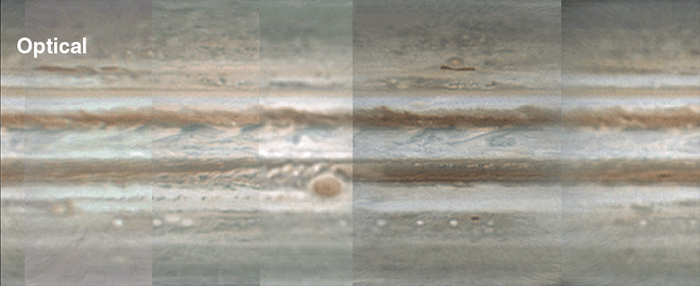.
New radio map of Jupiter reveals ammonia plumes beneath clouds
The nature of the gas giant’s atmosphere has long been something of a puzzle, but radio wave data has allowed scientists to peek beneath planet’s clouds

The radio map of the region (upper map) shows complex upwellings and downwellings of ammonia gas, that shape the colourful cloud layers seen in the approximately true-colour Hubble map below. Photograph: Michael H. Wong, Imke de Pater (UC Berkeley), Robert J. Sault (Univ. Melbourne). Optical: NASA, ESA, A.A. Simon (GSFC), M.H. Wong (UC Berkeley), and G.S. Orton (JPL-Caltech)
-
Huge plumes of ammonia have been found beneath the clouds of Jupiter, providing new insights into the planet’s dynamic atmosphere, scientists say.
Nearly 780 million kilometres from the sun and the largest planet in the solar system, the gas giant Jupiter has long fascinated astronomers. But the nature of its atmosphere has been something of a puzzle.
Jupiter’s clouds are known to be made from ammonia ice, but what is happening beneath that has proved challenging to unpick. “From the clouds themselves you cannot deduce how much ammonia is deeper down,” said Imke de Pater, professor of astronomy at the University of California, Berkeley, who co-authored the research.
In the 1980s, researchers working with the radio telescopes of what is now known as the Karl G. Jansky Very Large Array (VLA) in New Mexico found that the atmosphere of Jupiter contained very little ammonia - with the gas estimated to account for around 0.01% of its composition, says de Pater. But when the Galileo space probe hurtled through Jupiter’s atmosphere in 1995, descending more than 100 km, it detected levels of ammonia four to five times higher than expected.
Now scientists says they have solved the conundrum - Jupiter’s atmosphere contains a wave-like pattern of ammonia plumes.
Writing in the journal Science, a team of researchers from the US and Australia describe how they used radio wave data collected by the VLA, to peek beneath Jupiter’s clouds with greater resolution and sensitivity than was previously achieved.
When they analysed the resulting radio maps, the scientist found an intriguing feature. Around the planet’s equator they discovered a series of alternating dark and light patches in the maps, each tens of thousands of kilometres across, with the darker patches apparently larger than Jupiter’s famous great red spot.
.

This gif shows optical images of the surface clouds encircling Jupiter’s equator - including the famous great red spot - alternate with new detailed radio images of the deep atmosphere (up to 30kms below the clouds). Credit: Radio: Robert J. Sault (Univ. Melbourne), Imke de Pater and Michael H. Wong (UC Berkeley). Optical: Marco Vedovato, Christopher Go, Manos Kardasis, Ian Sharp, Imke de Pater.
-
These patches, the authors report, provide important clues as to the levels of ammonia present. “You see these large, dark oval shaped regions which shows there is a lot of ammonia gas in those areas,” said de Pater. By contrast the regions containing very low concentrations of ammonia correspond to the bright patches - also known as hot spots.
The researchers say the data provides new insights into Jupiter’s dynamic atmosphere. With the regions rich in ammonia found to extend around 100 km in depth, the researchers suggest that these are actually “plumes” of ammonia that are billowing up from deep within the planet’s atmosphere. As the ammonia rises, they propose, it cools and forms clouds of ammonia ice in the upper atmosphere. The remaining air then sinks back down again, creating a column that is very poor in ammonia. “That explains to us why overall, globally speaking, you can have much less ammonia gas, whereas at certain places you have a lot of ammonia gas,” said de Pater.
While the ammonia plumes were spotted near Jupiter’s equator, de Pater warns that it is not yet clear whether they exist elsewhere in the planet’s atmosphere.
But Scott Bolton, chief investigator for Nasa’s Juno spacecraft that is set to arrive at Jupiter in July, argues that it is not clear that the ammonia-rich regions revealed in the new study can really be described as plumes, pointing out that they are more like pockets of ammonia. “A plume to me implies a geyser - they have no evidence that geysers are coming out or anything like that,” he said.
Once the Juno spacecraft begins orbiting Jupiter next month, it will probe the planet’s makeup in a mission that scientists hope will help to shed light on Jupiter’s origins and evolution.
“The point of Juno is we go there with telescopes like the VLA, but [measuring] longer wavelengths,” said Bolton, adding that the technique will allow scientists to probe far deeper into Jupiter’s atmosphere while avoiding problems associated with such long wavelength measurements taken from Earth.
“There is a lot of really interesting things we can learn about Jupiter’s deep atmosphere and this is the tip of the iceberg,” he said. “I expect that when Juno gets there we will see lots of things associated with the dynamics of the deep atmosphere - much deeper that [this], and much higher resolution.”
Quelle: theguardian
4556 Views
